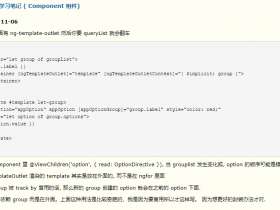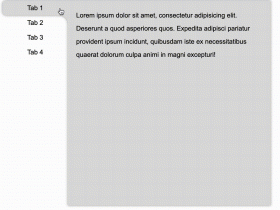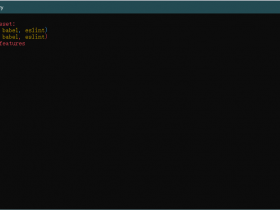- A+
JQuery
一、选择器
1.基本选择器
1)标签选择器: $("sel1")
2)id选择器: $("#sel1")
3)class选择器:$(".sel1")
4)通配选择器:$("*")
5)群组选择器:$("sel1,sel2")
6)特殊用法:
$("div.box")
补充:
//设置单个css样式 $("选择器").css("属性","值"); //设置多个样式使用对象 $("选择器").css({ background:"#ccc", color:"red" }); 2.层级选择器
1)包含选择器:sel1 sel2
sel1 下的所有子代(包括所有子孙代)
2)子类选择器:sel1>sel2
sel1下的子一代
3)相邻选择器:sel1+sel2
sel1后紧挨着的兄弟元素sel2(选出一个)
4)兄弟选择器: sel1~sel2
sel1后所有sel2元素(不需要相邻,可以选出所有)
3.伪类选择器
(1)特定位置选择器
1) :first:
2) :last
3) :eq(index) (索引从0开始)
(2)指定范围选择器
1) :even (索引为偶数)
2) :odd (索引为奇数)
3) :gt(index)
4) :lt(index)
(3)排除选择器
:not(选择器)
(4)匹配子元素的伪类选择器
与父元素相关。
1)E:first-child :
2):last-child
3)E:nth-child(index): ( nth 索引从1开始)
A . :nth-child(even):
B . :nth-child(odd):
C . :nth-child(index)
D . :nth-child(2n):
E . :nth-child(2n+1):
4 ) :nth-last-child(index):
与父元素无关
5 )E :nth-of-type(index):(从前往后)
6 )E :nth-last-of-type(index): (从后向前)
7)E:hidden (选择出 所有display为none的元素)
与父元素相关和与父元素无关
与父元素相关举例:
<ul> <li>我是ul1</li> <li>我是ul2</li> <p>你好你好</p> <li>我是ul3</li> <li>我是ul4</li> <li>我是ul5</li> <p>你好你好</p> </ul> <script> //与父元素相关,获取不到"我是ul5" $("ul li:nth-last-child(1)").css("background-color","blue"); //与父元素无关(nth-last-of-type),可以获取到"我是ul5"的li $("ul li:nth-last-of-type(1)").css("background-color","blue"); </script> 4.内容选择器
1):contains('内容')
2):empty (元素内容为空,空格不算空)
3):has(“a”)
5.属性选择器
1)$(“元素[属性='属性值']”)
2)$(“元素[属性!='属性值']”)
3)$(“元素[属性^='属性值']”) (^ 以“...”开头)
4)$(“元素[属性$='属性值']”) ($ 以“...”结尾)
5)$(“元素[属性*='属性值']”) (包含"...")
6.表单选择器
(1):text (选择出type为“text”)
(2):password
(3):submit
(4):radio
(5):checkbox
(6):button
(7):reset
(8):image
(9):file
(10):checked
(11):disabled (被禁用的表单元素)
(12):enabled (未被禁用的元素)
(12):selected
区分$(“input”)和$(“:input”):
$(“input”)是一个元素选择器,只能匹配input标记;
$(“:input”)是一个伪类选择器,几乎可以匹配所有的表单元素。
二、过滤器
过滤器不可以单独使用,必须跟在选择器的后面使用。
过滤器是对选择器查询出的结果进行第二次筛选。
1.$(选择器).过滤器
.first()
.last()
2.下标过滤器
.eq(index)
3.表达式过滤器
filter(expr)/(fn):筛选出与指定表达式/函数匹配的元素集合。
4.后代层次关系
(1).find("selecotr1") 查找所有子代
(2).children("selecotr1")
5.上一级层次关系
(1).parent()
(2).parents()
.parents(selector1)
(3).parentsUntil(selector1) 直到这个选择器,不包括这个选择器
6.兄弟关系
(1)下面的同级兄弟:
1).next()
2).nextAll()
3).nextUntil() 后面所有兄弟,直到...
(2)上面的同级兄弟:
.prev()
.prevAll()
.prevUntil(selector)
(3) .siblings() 前后所有兄弟
7.单一过滤器
.map() 映射
.not(selector)过滤
.slice(a,b)截取(包头不包尾)
也可截取string与array;
.has()包含
8.判定过滤器
.hasClass(className)
.is(表达式)
.css(一个值):获取样式(内联,内部,外部,未设置的样式)
9.串联过滤器
1.add(selector),将selector指定的选择器对象添加到选择器范围中。该过滤器的功能也可以利用群组选择器实现。
2.end(),将一个带有过滤器结构的jQuery对象返回其对应的选择器对象。
10.操作属性
(1).attr()(不能操作内置属性,用于操作常规属性,id,class,src等)
.attr(属性):一个值表示获取
.attr(属性,属性值):两个值表示设置
.removeAttr("属性"):
(2)prop()用于操作内置属性(比如checked,innerHTML等)
.prop(属性)
.prop(属性,属性值)
.removeProp("属性")
(3).addClass()
添加多个class:(1)addClass(class1 class2 class3)
(4).removeClass():移除class
(5).toggleClass(class1): 切换
(6)
.html():表示获取jquery对象的内容;
.html(参数):设置jquery对象的内容,传递的参数了可以为字符串,也可以为标签,也可以为“”
(7)
.text():表示获取jquery对象的文本内容;
.text("文本"):设置jquery对象的文本内容,但是不会解析标签,只能原样输出标签,当成文本传递。
(8).val() 获取值(表单input的值)
三、操作DOM
1.创建节点
$("<h1></h1>")
2.插入节点
内部插入
a.append(b) 在a的内部添加b
a.appendTo(b) a添加到b内部后面
a.prepend(b) 在a内部的前面添加b
a.prependTo(b)
节点剪切
如果是选择的是已存在的节点则会将已存在的节点剪切到指定位置
外部插入
a.after(b) 在a的外部后面添加b
a.insertAfter(b) 将a插入到b外部的后面
a.before(b)
a.insertBrfore(b)
节点包裹
//外包 $("span").wrap("<p></p>") //每个span外面,外包一个p标签 //总包 $("span").wrapAll("<p></p>") //所有span外面,整个外包一个p标签 //内包 $("div").wrapInner("<p></p>") //div内包一个p //卸包 $("span").unwrap() //可用于删除上一级父元素 删除节点
两种方法都可以删除节点,并返回被删除的JQuery对象 $("div").remove() //删除选择的节点(会删除原有事件) $("div").detach() //删除选择的节点(删除节点,但保留原有事件) //清空节点(只清空节点内容,不删除节点) $("div").empty() 节点克隆(复制节点)
传参和不传参的区别
$("选择器").clone() //不传参数true,不复制事件 $("选择器").clone(true) //复制节点,包括节点的事件 节点替换
js中标签替换
dom.outerHTML = "<p>我是被替换的标签</p>"
Jquery中节点替换
//指定元素替换成匹配元素 $("div").replaceWith("<p><p>") //用p标签替换所有的div //用匹配元素替换成指定元素 $("span").replaceAll("a") //用span标签替换掉所有的a标签 四、JQuery动画
1.显隐动画
$("选择器").show(speed,fn) speed为速度(毫秒数),fn为回调函数
$("选择器").hide(speed,fn)
$("选择器").toggle(speed)
2.显隐滑动效果
.slideUp(speed,fn)
.slideDown(speed,fn)
.slideToggle(speed,fn)
3.淡入淡出效果
.fadeIn(speed,fn) 淡入
.fadeOut(speed,fn) 淡出
.fadeToggle(speed,fn)
fadeTo(speed,opaity,fn) 指定改变到某个透明度
注:由于fadeIn()和fadeOut()的边界是1和0,所以使用fadeTo()就无法使用fadeIn()或者fadeOut()
4.自定义动画
.animate({属性1:属性值1,属性2:属性值2},speed,linear,fn)
第三个参数linear为匀速,默认值为easy减速
有先后执行顺序的动画(三种方式)
(1)将后执行的动画写入回调函数fn
(2)链式调用: $("选择器").animate().animate()
(3)队列式调用:$("选择器").animate();$("选择器").animate();
让图片水平居中在容器内部
(1)
将盒子定位到容器中间
left:50%
top:50%
用margin拉回
margin-left:-50%
margin-top:盒子高的一半
(2)
第一张图片:display:inline-block
让图片水平居中:text-align:center
让图片垂直居中:vertical-align:middle
注:由于vertical-align是相对于某个元素垂直居中,所以要加空白盒子
height:100%;
vertical-align:middle;
display:inline-block;
无缝滚动实例
思路:
1.设置当前索引curIndex,和前一张索引prevIndex。(curIndex为下一次要显示的图片索引,prevIndex为现在看见的图片)
2.点击下一张按钮,图片向左移动;点击前一张按钮,图片向右移动
3.滑动前将要滑入的图片放指定位置,现在的照片prevIndex划走,要滑入的照片curIndex进入
style样式
<style type="text/css"> * { margin: 0; padding: 0; } .box { width: 800px; height: 550px; border: 1px solid #000; margin: 50px auto; position: relative; overflow: hidden; } li { list-style: none; } .imgList { width: 800px; height: 550px; position: relative; overflow: hidden; } .imgList li { position: absolute; left: 800px; } .box img { width: 800px; height: 550px; position: absolute; left: 800px; } .btn { font-size: 40px; color: #fff; width: 50px; height: 80px; box-shadow: 0 0 18px #fff; position: absolute; top: 230px; text-align: center; line-height: 80px; border-radius: 50%; cursor: pointer; } #prev { left: 50px; } #next { right: 50px; } .nav { height: 50px; text-align: center; position: absolute; width: 100%; bottom: 30px; } .nav li { display: inline-block; width: 30px; height: 30px; background: #ccc; } .nav .on { background: #333; } </style> html主体部分
<div class="box"> <img style="left: 0px;" src="./img/images/show/9/1.jpg" alt="JQuery总结" /> <img src="./img/images/show/9/2.jpg" alt="JQuery总结"/> <img src="./img/images/show/9/3.jpg" alt="JQuery总结" /> <img src="./img/images/show/9/4.jpg" alt="JQuery总结" /> <img src="./img/images/show/9/5.jpg" alt="JQuery总结" /> <div id="prev" class="btn"><</div> <div id="next" class="btn">></div> <ul class="nav"> <li class="on"></li> <li></li> <li></li> <li></li> <li></li> </ul> </div> js部分(使用Jquery实现)
<script src="js/jquery-1.11.3.js"></script> <script> var prevIndex = 0; var curIndex = 0; $("#next").click(function() { //.is(":animated"):正在执行动画返回true,没在执行动画返回false if ($(".box>img").eq(curIndex).is(":animated")) { return; } if (curIndex >= $(".box>img").length - 1) { curIndex = 0; } else { curIndex++ } tab(); prevIndex = curIndex; }) $("#prev").click(function() { if ($(".box>img").eq(curIndex).is(":animated")) { return; } if (curIndex <= 0) { curIndex = $(".box>img").length - 1; } else { curIndex--; } tab(); prevIndex = curIndex; }) $(".nav li").click(function() { curIndex = $(this).index(); if (curIndex == prevIndex) { return; } tab(); prevIndex = curIndex; }) //左边按钮:向右边滑动; function tab() { //切大图; if (curIndex == 0 && prevIndex == 4) { //边界2,当前在最后一张,点击next //向左滑动:前一张向左滑动,当前那一张摆放在右边,滑动到当前位置; $(".box>img").eq(prevIndex).animate({ left: -800 }, 1000) $(".box>img").eq(curIndex).css("left", "800px").animate({ left: 0 }, 1000) } else if (prevIndex == 0 && curIndex == 4 ) { //边界1,当前在第一张,点击prev //向右滑动:前一张向右滑动,当前那一张摆放在左边,滑动到当前位置 $(".box>img").eq(prevIndex).animate({ left: 800 }, 1000) $(".box>img").eq(curIndex).css("left", "-800px").animate({ left: 0 }, 1000) } else if (curIndex > prevIndex) { $(".box>img").eq(prevIndex).animate({ left: -800 }, 1000) $(".box>img").eq(curIndex).css("left", "800px").animate({ left: 0 }, 1000) } else { $(".box>img").eq(prevIndex).animate({ left: 800 }, 1000) $(".box>img").eq(curIndex).css("left", "-800px").animate({ left: 0 }, 1000) } //切小点; $(".nav li").eq(curIndex).addClass("on").siblings().removeClass() } </script> 5.动画执行
清除动画计时器
.stop(true)
.stop(true,true) 传入两个值比传入一个值清除更快
判断是否正在运动
.is(":animated")
五、Event事件
一、定位与尺寸
1、获得jQuery对象的尺寸:
(1).css(“width”)获取width(带有px),和margin/padding/border无关。
(2).width()/.height():获取width(不带有px),和margin/padding/border无关。
Js:offsetWidth:获取的是width+border+padding(不带单位),与margin无关。
(3).innerWidth()/innerHeight()获取的是windth+padding(不带单位),与border与margin无关。
(4).outerWidth(true):获取width+padding+margin+border(不带单位)
.outerWidth(false):获取width+padding+border(不带单位)==js的offsetWidth
(1)区别$(document).width():大小取决于内容的大小
(2)与$(window).width():取决于window窗口的大小
2、获得jQuery对象的定位位置
(1)绝对定位:利用offset()方法获得的定位对象又具备两个属性:
.offset().left:永远相对于浏览器的位置,元素相对于document的left(不带)
(2)相对定位:jQuery对象使用position()方法获得相对定位对象。
取决于父元素写了position定位的父盒子。
.position().left
二、滚动事件:
scrollLeft():设置/获取水平滚动条滚走的左侧距离。
scrollTop():设置/获取垂直滚动条滚走的顶部距离。
不传值表示获取垂直滚动条滚走的顶部距离。
传值表示设置值。
三、Event事件:
1、Event属性:
type:获取事件类型名称
target:发生事件的节点
keyCode:只针对于keypress事件,获取键盘键数字 按下回车,13
2、鼠标位置
pageX:光标对于页面原点的水平坐标 body,document
pageY:光标对于页面原点的垂直坐标
clientX:光标对于浏览器窗口的水平坐标 浏览器
clientY:光标对于浏览器窗口的垂直坐标
screenX:光标对于电脑屏幕的水平坐标 电脑屏幕
screenY:光标对于电脑屏幕的垂直坐标
offsetX:鼠标相对于事件源的位置
offsetY:
3.阻止冒泡
stopPropagation()
4.阻止对象的默认行为
preventDefault()
5. 事件绑定
(1)on()与bind()方法基本相同
$("btn").bind("click",function(){...}) //同一个元素写不同事件执行相同的方法 $("btn").bind("click mouseover mouseout",function(){...}) //同一个元素写不同事件执行不同的方法(写成对象的方式) $("btn").bind({ click:function(){...}, mouseover:function(){...} }) 不同点:on(事件,selector,参数,fn),on存在事件委托;
//h1将事件click委托给body,实际上仍然是“h1”操作 $("body").on("click","h1",function(){...}) (2)自定义事件
.bind("say",function(){...})
触发自定义事件
.trigger("say")
注:如果js有的事件,但是JQuery中没有,需要进行事件绑定使用,但是不需要触发。
(3)移除绑定事件
移除元素绑定的所有事件
.off()
.unbind()
移除特定事件
.unbind("click")
移除特定事件的特定方法fn
.unbind("click",fn)
(4)one(事件,fn)
该事件只执行一次。常用于请求后台数据时。
四、事件类型名:
1、鼠标事件:(7个)
click(鼠标单击左键)、dlbclick(鼠标双击左键)、mouseover(鼠标划入)、mouseout(鼠标划出)、mousemove(鼠标移动)、mouseenter(鼠标进入)、
mouseleave(鼠标移开)、mouseup(鼠标抬起)、mousedown(鼠标按下)。
Mouseenter与mouseover的区别:mouseenter只作用于本身,不会作用于子元素。
2、键盘事件:(3个)
keypress、keyup、keydown
3、表单元素事件:
表单事件:
(1).submit():form.submit()提交
.submit(fn):当提交时执行fn函数
(2)form.reset():重置 只针对dom元素
当重置时执行
$("form").bind("reset",function(){ alert("确定重置吗") }) 表单元素事件:
.focus();获得焦点
.focus(fn):当获得焦点时执行
(1)blur():同focus
(2).focusin()
(3).focusout()
(4).change():当改变时执行;
(5).select():选中
.select():输入框里的值被全部选中
.select(fn):当输入框的值被选中时执行fn
(6)input():作用于所有form元素(要使用事件绑定)
4、浏览器事件:
resize():当浏览器的大小发生变化时触发该事件。
.scroll():当浏览器滚动条发生滚动时触发该事件。
5、其它事件:
.load():当页面加载后触发该事件,多用于JavaScript的window对象中。
.unload():当页面卸载(关闭页面)时触发该事件。
.Beforeunload():离开页面(更新网址,关闭网页)之前执行; .error():当图片加载失败时触发该事件。
6.释放JQuery
$.noConflict()
仅仅释放JQuery的$,JQuery仍然代表JQuery
可以指定新字符代表JQuery
var j = $.noConflict(); //j代表JQuery 六、JQuery异步操作(Ajax)
1.js中的Ajax
js中的Ajax
//1.创建对象 request = new XMLHTTPRequest(); //2.链接后台 request.open("GET","接口地址"); //3.发送 request.send(); //请求成功 request.onload=function(){ data = request.responseText; //返回的数据 console.log(JSON.parse(data)); } //请求失败 request.onerror=function(){ } //请求状态改变 request.onreadystatechange=function(){ } Promise
三种状态(状态不可逆)
1.Pending(待定):初始状态,既没有被兑现也没有被拒绝
2.fulfilled(已兑现):操作成功完成
3.regected(已拒绝):操作失败
//成功执行then,失败执行catch new Promise(function(resolve, reject) { var request = new XMLHttpRequest(); request.open("GET","接口地址"); request.send(); request.onload = function() { //resolve提交到then resolve(request.responseText) } request.onerror = function() { //regect提交到catch reject("error"); } }).then(function(res) { console.log(JSON.parse(res)) var val = JSON.parse(res); console.log(val.data[1].icon); }).catch(function(rej) { console.log(rej) }) 2.JQuery中的异步请求
链接网页
$("sel").load("head.html") $.get()和$.post()
$.get()与$.post()使用方式相同
$.get()传参的三种方式
(1)url传参(问号分隔)
$.get("地址?type=1",function(res){...})(2)字符串传参(多个值用&分隔)
$.get("地址","type=1",function(res){...})(3)JSON传参
$.get("地址",{type:1},function(res){...})
$.ajax
$.ajax({ type:"get", url:"地址", data:{type:"值"}, success:function(res){ //请求成功返回的数据 console.log(res); }, error:function(rej){ console.log("error"); } }) 不同页面间传递数据
1.浏览器存储传参
//存值 localStorage.setItem("myId","值"); //获取值 localStorage.getItem("myId"); 2.url地址传参
地址栏中通过?分隔传参,传多个参数再用&分隔
window.location.search得到url中的参数
//获取地址栏中参数的值,name为参数的名字 GetQueryString: function(name) { //定义正则,用于获取相应参数 var reg = new RegExp("(^|&)" + name + "=([^&]*)(&|$)"); //字符串截取,获取匹配参数值 var r = window.location.search.substr(1).match(reg); // console.log(r) //但会参数值 if (r != null) return r[2]; return null; } 拓展:url中的参数加密和解密:
加密:
u=encodeURIComponent("要加密的str");
解密:
decodeURIComponent(u)




